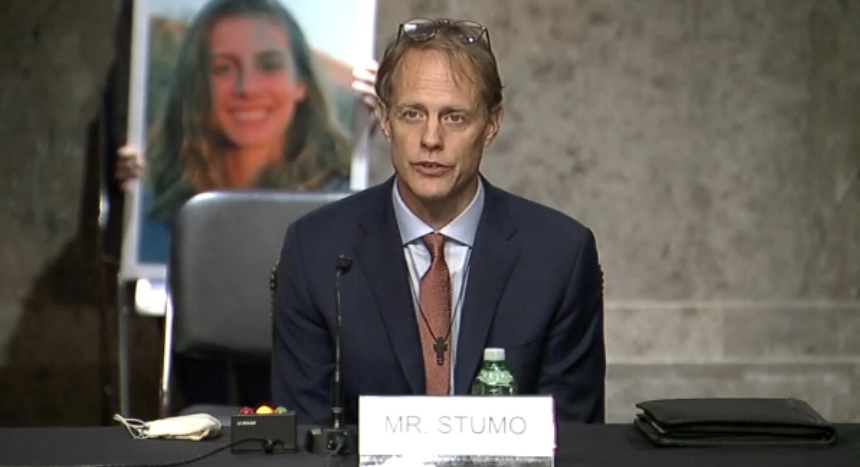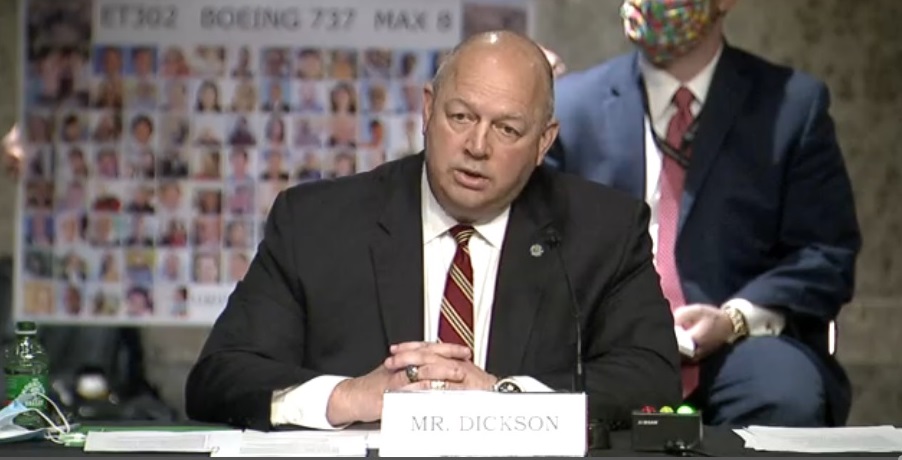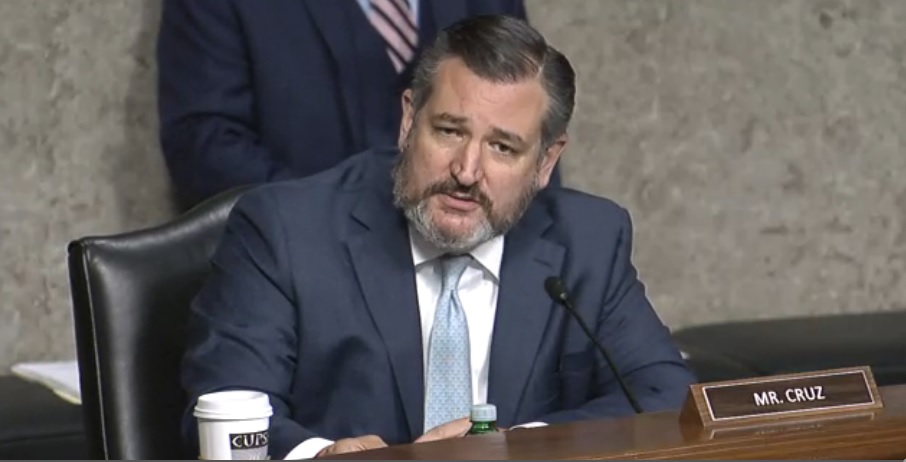Michael Stumo who lost his daughter, Samya Rose Stumo, in the crash of a Boeing 737 Max in Ethiopia, testified this morning at a hearing of the Senate Commerce Committee.
Stumo was invited to testify following testimony of Federal Aviation Administration (FAA) head Steve Dickson.
Stumo said that while Boeing executives have been saying sorry to the cameras for the two Boeing Max crashes that killed 346 passengers and crew, Boeing says something entirely different when facing families in court.
“Boeing apologizes and says – we are very sorry, we are going to do better – but in court they say – we don’t have to pay anything because the FAA certified the plane and that makes us immune,” Stumo said. “And that’s wrong. And the FAA in other cases has supported that position. And I don’t like it. That should change. And legislation should make that clear.”
“Boeing executives may bow their heads and express sorrow for the crash,” Stumo said. “But in private they are doing everything possible to prevent families from holding Boeing accountable. Boeing is asserting, in court, that the fact of FAA certification pre-empts families from making claims for the loss of our loved ones. Boeing’s conduct should not be awarded with immunity.”
Stumo said that as part of aviation reform legislation, Congress “should make clear that FAA certification is the bare minimum that manufacturers like Boeing should meet.”
“While I hope no family has to experience the loss of a loved one in a plane crash, legislation should preserve the right to hold all responsible parties accountable.”
“On March 10 last year, my daughter Samya was traveling on her first international assignment for her employer,” Stumo testified. “She had recently graduated from the University of Copenhagen School of Public Health and landed her dream job at ThinkWell in January 2019 to help cause patient centered change in the global health field.”
“Samya flew from Dulles to Addis Ababa. After she arrived, Samya texted us, ‘Just landed in Addis Ababa – another 2 hours to Nairobi.’”
“She boarded a Boeing 737 MAX 8 at around 8:30a local Addis time. She sat in seat 16J, an aisle seat. Flight ET302 was a daily flight between the two cities, often carrying US diplomats to and from Nairobi. The plane was only four months old.”
“As flight ET302 took off, something went wrong with the left hand angle of attack (AoA) sensor.”
“There was another AoA sensor on the co-pilots’ side. It was working properly but it was not connected to the MCAS system.”
“The MCAS system wrongly kicked in, repeatedly pushing the nose down soon after takeoff.”
Stumo quoted the testimony of Captain Sully Sullenberger from earlier this year:
“The failure of an AOA sensor quickly caused multiple instrument indication anomalies and cockpit warnings. And because in this airplane type the AOA sensors provide information to airspeed and altitude displays, the failure triggered false warnings simultaneously of speed being too low and also of speed being too fast. The too slow warning was a ‘stick-shaker’ rapidly and loudly shaking the pilot’s control wheel. The too fast warning was a ‘clacker’, another loud repetitive noise signaling overspeed. These sudden loud false warnings would have created major distractions and would have made it even harder to quickly analyze the situation and take effective corrective action.”
“For several minutes, the captain used brute physical force to pull the control yoke back up,” Stumo said. “He became exhausted and asked for the first officer’s help. During the six minute flight, my daughter was terrified riding this roller coaster. At 8:43 am local time, the plane plowed into the ground, in an Ethiopian farm field, and buried itself dozens of feet below the surface. The plane and the passengers disintegrated into pieces. Their parts were mixed up with the jet fuel. I was there. My family and I were at the crash site. We saw the wreckage. My wife and son saw body parts exposed to the elements.”
“The MAX is an Obama era plane that was certified to fly in March 2017, the third month of the Trump administration. It is a deadly aircraft with ill-fitting engines bolted onto a 50 year old aircraft design. Rather than physically fixing the aerodynamic design of the aircraft, Boeing took the cheap route. It used glitchy software that relied upon input from a single sensor to push the nose of the plane towards the ground in certain conditions.”
“Even today, the FAA still has not resolved the issue of whether MCAS exists to make the MAX handle like prior planes or to resolve aerodynamic instability. Until FAA can answer that question, the MAX should not fly again. It may be that the aircraft is so flawed that physical
changes, rather than software fixes, are required.”
“Boeing hid MCAS for many years. In June 2013 the company first devised a plan to conceal MCAS from the public and to minimize its existence for the FAA. It was described as merely ‘an addition to [the existing] speed trim [system]’”
“In 2016, Boeing drastically strengthened MCAS’ ability to push the MAX’s nose down. It never informed the FAA or anyone else of this change. Neither Boeing nor FAA performed a safety assessment which was necessary for critical safety systems. In May 2019, then-Acting FAA Administrator Dan Elwell admitted that Boeing and the FAA failed to designate MCAS as a safety critical system.”
“The MCAS violated Boeing’s internal requirements requiring that the systems should ‘not interfere with dive recovery’ and ‘not have any objectionable interaction with the piloting of the airplane.’”
“The effort to hide MCAS continued throughout 2016 as the FAA allowed Boeing to remove references to MCAS from Boeing’s Flight Crew Operations Manual.5 The company wanted to avoid simulator training. In November 2016, Boeing chief technical pilot Mark Forkner wrote to a colleague that he was “jedi-mind tricking regulators into accepting” lesser pilot training.”
“One Boeing employee rejoiced when the FAA said there should only be computer-based training, without a simulator. ‘You can be away from an NG for 30 years and still be able to jump into a MAX? LOVE IT!!… This is a big part of the operating cost structure in our marketing decks.’”
“In 2017, a Boeing employee wrote, about the MAX, ‘This airplane is designed by clowns, who are in turn supervised by monkeys.’ In 2018, another employee wrote ‘I still haven’t been forgiven by God for the covering up I did last year.’”
“The FAA’s years-long drive to delegate everything and relegate staff to paper pushers and presentation watchers resulted in Boeing employees mocking them as ‘dogs watching TV.’ The FAA remains happy to be sidelined, rather than have direct involvement in certification.”
“It is absolutely critical that excessive delegation is fixed,” Stumo said. “FAA must not be allowed to slump further into paper-pusher status, distant from Boeing engineering and the plant production floor. FAA must retain direct involvement in critical safety systems — as well as novel and new systems — and not delegate its functions to Boeing. Critical safety systems are those deemed major, hazardous or catastrophic. FAA must verify that the fault tree analysis and other analysis are performed to guarantee redundancies and fail safes to prevent failure. New and novel systems are, like MCAS, those not included on aircraft and not fully tested in the past.”
Earlier in the hearing, FAA administrator Dickson refused to give the thumbs up to bipartisan legislation that would give the FAA more control over safety inspectors.
Dickson said changing who selects company insiders — from manufacturer to the FAA — to do oversight work “is not something that I believe would add to the safety of the process.”
Senator Ted Cruz put Dickson on the hot seat.
Cruz: Mr Dickson, well over a year ago you sat before this committee in your confirmation hearing. At the time I and others told you to be pissed off at what had happened.
You’ve been in office 329 days. We’ve heard today that you’re stonewalling the chairman’s investigations, that you’re refusing to answer multiple letters from at least one of my colleagues on the other side of the aisle — Senator Richard Blumenthal — and that you’ve yet to provide responsive documents to Mr. Stumo’s FOIA request filed eight months ago.
Let me ask you some simple questions.
In the process of certification of the 737 Max, did Boeing lie to the FAA?
Dickson: I can’t say, I can’t say I mean definitely there was incomplete information and fragmented information that was provided. No doubt.
Cruz: Why didn’t one of their senior test pilots Mark Forkner write “so I basically lied to the regulators unknowingly.”
Dickson: I don’t know, I can’t speak for him I don’t know what he meant by that.
Cruz: So in 329 days what have you been doing if not figuring out whether they lied and what they lied about?
Dickson: I’m interested in learning from the past, and making the process and the agency more effective and better going forward. The important point is that the information was not provided in the way that it needed to be provided. That in itself degrades the trust that we need to have that’s a foundation to the certification process.
Cruz: Okay, let’s learn from the past. Did the FAA screw up in certifying the 737 Max?
Dickson: I have concerns. I would say that there were mistakes made, yes.
Cruz: In Washington the passive voice is a classic tell. “Mistakes were made” is a great way of avoiding responsibility, because there is no actor in that phrase – “mistakes were made.”
Who made the mistakes and why? Don’t speak in the passive voice.
Dickson: The manufacturer made mistakes, and the FAA made mistakes in its oversight of the manufacturer.
Cruz: And what were the mistakes and why were they made?
Dickson: The full implications of the flight control system were not understood as design changes were made.
Cruz: Has anyone at FAA been fired?
Dickson: There have been changes in leadership in various areas. No one has been fired over this particular matter, up to this point.
Cruz: Has anyone been disciplined over this matter?
Dickson: No, not specifically.
Cruz: So, unknown somebodies made unspecified mistakes for which there had been no repercussions, is that right?
Dickson: I would not say that there have not been real repercussions.
Cruz: Well, please tell us the repercussions
Dickson: The repercussions are that we are making significant reforms to the process. And, and we are standing up audit processes and review processes and more robust safety systems so that we can be more effective in the future as an organization.
Cruz: Is there a systemic problem of agency capture at the FAA?
Dickson: I don’t believe that it is agency capture. But I do believe that when you have very capable technical subject matter experts, they get focused on their checklist, or their part of the process, they hold themselves accountable for that, and they don’t always see the whole picture. So that’s why we as leaders must make sure that we are taking an integrated approach in our dealings in this case with a manufacturer or air carrier or whatever that whatever the private sector regulated party is that we are responsible for overseeing.
Cruz: Mr. Dickson, you said in your opening statement – safety is a journey, not a destination.
For the 346 souls lost to the two 737 Max planes that crashed, safety was all about arriving at their destination. They should have arrived at the destination at Boeing not covered up serious safety concerns, number one, and had the FAA done its job of making sure that the MCAS was not put in the field without pilots being appropriately trained.
I think the concern this committee has is we’re not seeing from you any of the urgency of fixing this problem. It is very easy to go into an agency and yourself get captured by the agency.
You understand, sir, that you do not work for the airlines and you do not work for Boeing. You work for the American people. And this committee expects that when we ask questions specifically about malfeasance that cost the lives of 346 people that you will be forthcoming and answer those questions. I’m hopeful that’s the conduct we’ll see going forward.


